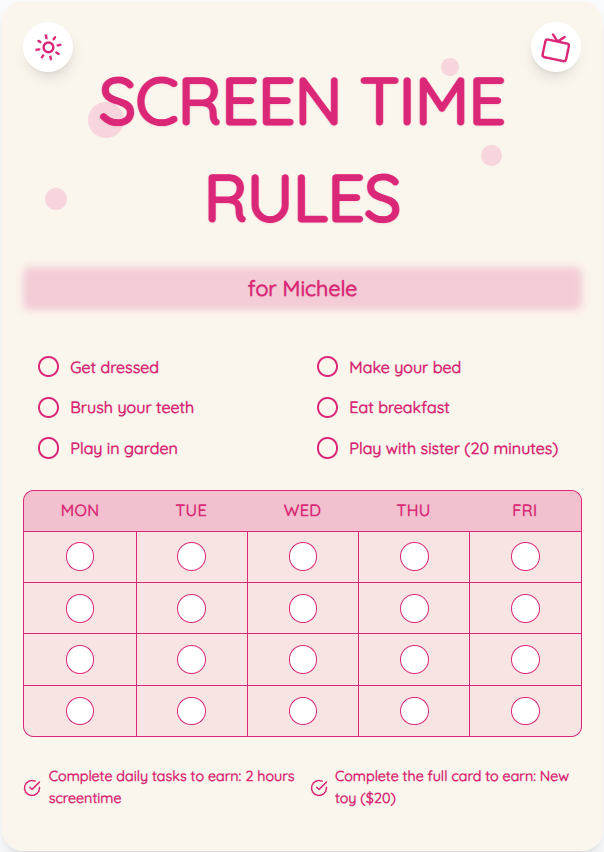Screen Time Guidelines for Parents: Expert Advice & Practical Tips
As a parent, managing your child's screen time can be challenging. In this guide, we provide expert advice and practical tips to help you navigate the world of screen time effectively. Discover how ScreenTimeRules.com can assist you in creating a balanced screen time routine for your child.
See What Your Screen Time Chart Will Look Like
Here's an example of a beautiful, customizable screen time rules chart you can create for your family

Understanding CDC Screen Time Guidelines
The CDC recommends that children aged 2-5 years should have no more than one hour of screen time per day, while children aged 6 and older should have consistent limits on the amount of screen time they consume. It's essential to balance screen time with other activities like physical play, social interaction, and educational pursuits.
Creating a Healthy Screen Time Routine
Establishing a screen time routine can help your child understand when it's appropriate to use screens. Set clear rules and boundaries, designate screen-free zones in your home, and encourage offline activities. Consider using a screen time chart generator from ScreenTimeRules.com to create a visual schedule for your child.
Put These Tips Into Action
Create a custom chart to implement these strategies with your child
Monitoring and Supervising Screen Time
Regularly monitor the content your child is viewing and engage in co-viewing activities to ensure they are engaging with age-appropriate and educational content. Be present during your child's screen time to guide them and discuss what they are watching. Use parental controls and set time limits on devices to manage screen time effectively.
Promoting Balanced Activities Beyond Screens
Encourage your child to participate in a variety of activities beyond screens, such as outdoor play, reading, arts and crafts, and family bonding time. Limit screen time before bedtime to promote better sleep quality and overall well-being. Screen time charts can help allocate time for different activities throughout the day.
Practical Tips for Success
- Set specific screen time limits for different activities (e.g., educational apps vs. entertainment)
- Encourage physical activity and outdoor play as part of your child's daily routine
- Use positive reinforcement and rewards for adhering to screen time rules
- Model healthy screen habits by limiting your own screen time when around your child
Frequently Asked Questions
How can I handle resistance from my child when setting screen time limits?
Communicate openly with your child about the reasons behind screen time limits. Involve them in creating the rules and offer choices within those boundaries. Consistency is key in enforcing limits.
Are educational apps considered beneficial screen time?
Educational apps can be valuable if used appropriately and in moderation. Look for apps that align with your child's learning goals and offer interactive, age-appropriate content.
What are the signs that my child may be spending too much time on screens?
Signs include irritability when screens are taken away, declining academic performance, disrupted sleep patterns, and a lack of interest in other activities. Monitor your child's behavior and adjust screen time limits accordingly.
By following these practical guidelines and incorporating screen time charts into your routine, you can create a healthy balance that supports your child's development. Visit ScreenTimeRules.com to explore customizable screen time charts that make managing screen time fun and easy!
Ready to Transform Your Family's Screen Time?
Join thousands of parents who have successfully managed screen time with our customizable charts.
